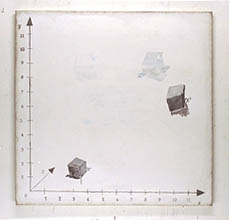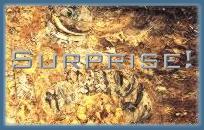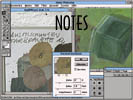A Visual Kit for Image Systems in the Art of Painting
by Christoph Kern (1) I. In painting, usually actual colors have to be applied to rectangular surfaces side by side or one layer over the other. The picture's meanings depend on the method and technique into which this is done. Nothing else. The knowledge about this symbolizes a wide range of mind's ability. My artistic interest now can be put as this: "How does painting work?" II. I realized very quickly what the artistic worlds had to offer to me: The brains of other artists would introduce me to a multitude of new perspectives and new realities. I attempted to absorb these worlds of strange images and thoughts. This was most successful when I used some kind of mimetic, step-by-step comprehension. I asked myself, how the things, that fascinated me in a work of art - things I could name precisely only on very rare occasions - were produced on the basic technical level of "brush and color."; New ways of seeing emerged during the process of comprehension. It enabled me to observe works of art from rather distinct points of view. The worlds I generated out of these new and differing visual realities inevitably became my own. III. First I had to work out the concepts for the paintings. On the basis of rather accidentally produced and spontaneous image variations gradually active tendencies developed which needed affirmation or denial and waited to be kept or destroyed. In this way I devised an abundance of schemes which could be mixed together, changed and tested until promising image sequences developed from them. I found it very remarkable that almost any composition could come to a sufficiently peculiar image constellation to be at least temporarily considered. IV. The objects I chose as motifs for my paintings should for themselves mean as little as possible. Cubes. These cubes became the models for the visual elements and for the choice of forms and colors in my paintings. They were cubes like the building blocks I had played with as a child; they carried only their concrete meaning but by cleverly putting them into order one could use them to build everything one could think of. Depicted objects in the visual arts usually carry a priori meaning. However, the motifs of my paintings were as empty as possible of any meaning of its own; the viewer should still be able to perceive that it is an object. The cubes thus functioned as variables which I had to turn into meaningful elements only in the artistic work. Real building blocks enabled me to produce exciting constellations without any preordained meanings distracting me from their true artistic potential. All that the paintings could possibly become had to be created through the specific use of form and color. In a playful and interactive fashion I could thus rework actual perception into symbols, compare substitute and reality, and examine the technical processes of painting I described above. The artistic frame of reference "perception - imagination - depiction" had come full circle. V. Of course I was intrigued with the cubes also because of something Umberto Eco describes in respect to Morandi's variations of still lives as "A Metaphysics of Everyday Things". His definition was rather limited but it allowed him to create a "macrocosmos". In a speech Eco gave at an exhibit opening of the Morandi Museum in Bologna, he talked about what most impressed him in Morandi's work. It was the fact that the paintings always seemed different, no matter how often he looked at them: A slight alterating of the lighting or a small step to the side and already everything was changed. Eco emphasized that the revelation in Morandi's art was the simultaneity of innovation and variation within a medium of almost complete monochromatics. He said: "I think we will only grasp the full genius of Morandi, when we are able to discover with the help of more refined electronical methods what an enormous amount of newness, how many variations between one painting and the next his brush managed to squeeze on to one square millimeter" (2). Here I hear Eco saying something which for me as well seems more than obvious: It could not well have been the ceramic pots, which were the real interest of Morandi. They were rather the carrying substance on which he created much more complex formulations. Obviously there was a meaning which could not be understood just by identifying the narrative contents. Ernst Gombrich notes a similar process: "The meaning of an object in a painting is, one could say, not so much an interest from the outside. Rather it creates an additional dimension and participates in the development of a web of relations. [...] there remains the fact that something happens to the motif,- the nude or the still life when it is changed into forms and colors, is idealized or distorted. This element, never to be missed in Picasso or Klee, contributes to the highly complicated arrangement of a painting" (3). VI. I am working with only a few actual canvasses. The basic idea is to find in every run a new constellation, which modifies the previous one without altering the canvas or its main parameters. I isolate certain qualities of the painting techniques from works of art which I know and admire and apply them to my work as precisely as possible. Thus I try to find exciting and effective image constellations. When an image comes to the point of an effective formation I document it by taking a photograph. Sometimes I arrive at this formation immediately and very quickly, at other times it is only achieved after a tedious creative process. In between these documented constellations "happen" other ones I do not consider worth documenting. After documenting an effective formation I again send the image system "on the move" by modifying color and form. Based on the painting which already has emerged I work out its next effective formation. Every step of iteration recalls the previous, as a whole the final formation contains and remembers all the earlier constellations. The German Duden(4) of 1983 defines iteration in mathematics as "a step-by-step method of calculation to achieve an ever closer approximation of the exact result." I use the term iteration to mean the built-up of image formations which progress into ever more complex units by a continuous feed-back with previous formations and by constantly re-absorbing and re-including all that was before. However, I also want to quote (again from the Duden) the second definition of the term iteration which is taken from psychology. It gives a hint at the less successfull sides of an iterative process: "Compulsive and continuous repetition of the same words, sentences and the same simple movements (esp. in certain psychological and neurological diseases)". Based on the first definition I became more and more convinced of the following hypothesis about image production: The quality of a work of art is substantially improved when the painter "sticks to it"; if he or she revises it again and again, if he confronts the same artistic problem not only once, but over and over again. This happens both on the level of thought and on the level of craftsmanship. I am convinced that the acquired substance can be perceived in the final painting even if the layers of color underneath are no longer really visible. It is necessary to let one layer react to the previous layers as carefully and convincingly as possible. A simple adding-on of more color can by no means be a substitute for the kind of substantial materiality I want to procure! VII. Generating 3-D based constructions for my drafts and processing the pictures I took with the camera on the computer added another dimension to my project. I concentrated more and more on the "interface" between worlds of images which were created traditionally - through painting - and generated - virtually - on a computer. I admit that there are huge differences between a painting and the cyberspace; however, I think these differences are rather a matter of graduation and not of principle. I surmise that a battle scene in a Tizian painting was considered by its contemporaries as real as today's stroll through a virtual simulation. Incidentially, even as the actual illusionary qualities of cyberspace are truelly remarkable, they are but still a far cry from its makers' prophecies. I tried not to mystify any media and started to extract their respective and specific qualities. This reflection is one of the main subjects of my work. However, the computer not only broadens the range of artistic means at my disposal, most of all it influences my patterns of thought and the ways in which I approach my artistic work. As a matter of fact the computer has thus become an integrated tool of the artist: Like when I used pencil, brush, and color I now had to experiment again WHAT could be done best WHEN, using WHAT materials and HOW do I have to do that. THE VISUAL KIT AND ITS ARTISTIC SCORES I. In the following text I define everything as an image system that is noted as a result or partial result depending on differing artistic basic ideas. The image system I will describe here I name the visual kit. With the visual kit I started to make use of the availability of the cubes. They were the concrete starting points, but I could alter their arrangement whenever I needed to, both in reality and in the painting. In a word, I had found a challenging object that I could entirely subordinate to the demands of the image system. II. Actual tangible arrangements of the building blocks offered the real kind of resistance, real objects of friction, and they provided the needed formal potential. They inspired my fantasy to develop exciting artistic concepts and to re-work the objects into actual, two-dimensional paintings. With the help of the cubes I created several different arrangements which served as the informational background when I simulated "still lives"; or "landscapes" on the paintings. Thus I arranged the cubes for example on a plane which was illuminated by a single source of light. The lighting created clearly visible shadows. I slightly moved the four cubes on the plane, changed the direction of the light, or altered the point of view of the observer. Thus I produced several different views which emphasized the interesting overlap of "background", "shadow", "object". From this I developed exhilarating drafts for paintings. Later I produced my drafts with a 3-D construction program that allowed me to influence all parameters more easily and thus to generate a useful number of formations. It allowed me to program movements of the cubes. The cubes changed their positions, their forms, their shadows, their materials. A great number of variations was generated. I select and apply to my paintings the "fittest" constellations out of these animations. III. The image system consists of a range of basic concepts. One of its decisive components are the "SEQUENCES". I define SEQUENCE as a succession of paintings in which each new image formation derives from the previous formation. From the succession of paintings comes forth unique results which remain images in their own right. These I call SINGULARS. SEQUENCES and SINGULARS both consist of and form several subsystems of their own. These subsystems either break down the unity of the artistic aspects or they put them together in new contexts. SEQUENCES. Fundament and starting point of this image system are the SEQUENCES. They are based on the idea that if the artist reworks an image several times under similar conditions its meaning is deepened. May be its meaning can even only be extracted gradually through this process. Just by way of their method of production the individual paintings, the SINGULARS, are thus not fundamentally different from the SEQUENCES. They simply are the material results coming out of a sequence and as such they can stand on their own apart from the sequence. In the SEQUENCES I develop images from one iteration to the next until they reach a formation, which to my "expert's eyes" seems effective. Each formation had to be an intensified expression of its specific point of departure and as such needed to be a finished work. Each formation is on its level an effective painting as well. Then I move on and modify and differentiate the system. From each one of these effective formations I make a photographic document. Any longer period of creation becomes a decision-making system which decides where to go at the crossroads - one always could think of a hundred other ways one could have chosen. I want to document this process of creation as completely as possible and thus included into the artistic process the color palettes and possible mixes I used at certain times. There are detailed notes about each formation, the point of time of its creation, palettes, mixings (see p. 76/ 77 of the German book). This process corresponds to what I believe is meant in painting with "create substance". It is a reflection upon the iterative character of my image system. This still holds true even when one is aware that the final material result will not always and necessarily be the best of all possible solutions. As a rule one can only know from hindsight whether an interim result would have maybe been the most satisfying image. Obviously only the last formation of the SEQUENCES can be visible as the actual original work of art. The set of photographs coming out of documenting the SEQUENCES I re-process for example in the ANIMS (see below) which I define as a complete and separate work of art. SINGULARS. With the SINGULARS the image develops linearly from one promising formation to the next. They can be intensified to a point where I decide to preserve the at this time best formation of the image. A SINGULAR might thus be defined as a painted work of art in the traditional sense. SINGULARS sometimes happen "al prima"; namely when a promising formation of the image emerges rather quickly in the modification process. At other times constellations entirely dissolve into non-representational paintings and in the end the creative process can only be felt as a material substance, as a body of color. These become literally abstract or abstracted paintings. RELICS. In some SEQUENCES it turned out that the most interesting iterative formation and thus its qualitative culmination took place somewhere in the middle of the SEQUENCE, and not, as with the SINGULARS, at the happy ending of the SEQUENCE. They are called RELICS. The final products of a SEQUENCE which in such a case never came to be unique paintings, I do not usually keep, but reintegrate into a new creative circulation. VISPATS. (Visual Patterns) VISPATS are a kind of work format - mostly on paper - which I use to experiment with a whole range of diverse ideas. I also use the term VISPATS for sketches of compositions and drafts. The vispats are probably the most playful and least confined work with the VISUAL KIT. Here I try out everything that can be done with cubes. Here I train flexibility without thinking about conceptional applicability and usefulness. This seems to be exactly the reason why the VISPATS often are a highly inspirational source for new concepts. ANIMS. ANIMS are animations, i.e. short films, which simulate, clarify, and illustrate the developments in mind from one real, actual and photographed formation of a SEQUENCE to the next. ANIMS are visualizations of the "films" and thoughts which really are going on only in my mind. They are relatively short film clips that can run in continuous play on the computer screen. IV. Despite all my thoughts and methods of systematizing and analyzing I am still engaged in the creation of paintings. I simply slow down the creative process. I achieve this deceleration when I stop at certain crucial moments and take a picture of the formation and thus document it. To this I add any pertaining information about the creative process. Thus I manage to "freeze" certain single powerful images as in slow motion. This process contributes to the evaluation of my own work. These images represent in a way the web of my memories. |




